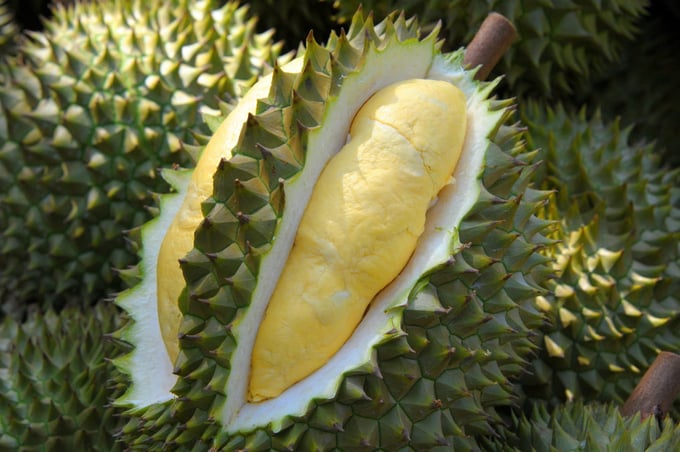December 4, 2025 | 05:06 GMT +7
December 4, 2025 | 05:06 GMT +7
Hotline: 0913.378.918
December 4, 2025 | 05:06 GMT +7
Hotline: 0913.378.918

China spent nearly USD 3 billion to purchase Vietnamese durian. Photo: Le Hoang Vu.
China imported 1.56 million tons of durian in 2024, valued at roughly USD 7 billion, up 9.4% in volume and 4% in value from 2023, according to the General Administration of Customs of China. Over the past year, Thailand has continued to be the primary supplier of durian to the Chinese market. More specifically, China imported nearly 810,000 tons of durian from Thailand, which was valued at over USD 4 billion. This represents a 13% decrease in volume and 12% decrease in value when compared to 2023.
China experienced a substantial increase in its imports of durian from Vietnam in 2024, with a 49% increase in volume and a 38% increase in value compared to 2023. The total volume of imports was 738,000 tons, and the value was USD 2.94 billion. At USD 4,957 per ton in 2024, the average import price of durian into China was a 4.9% decrease from 2023. Notably, the average import prices of durian from the Philippines and Vietnam decreased, while the average import price from Thailand increased.
The General Department of Vietnam Customs' statistics suggest that durian played a substantial role in the overall expansion of the fruit and vegetable sector in 2024. Consequently, durian exports comprised 45% of the total fruit and vegetable export value, with a 43% increase from 2023 to USD 3.21 billion. In 2024, the export value of a variety of other fruits and vegetables increased in comparison to 2023. These items include coconuts (up 61%), bananas (up 20%), mangoes (up 47%), jackfruit (up 22%), pistachios (up 77%), almonds (up 65%), and jalapeno peppers (up 15%). Conversely, the export value of dragon fruit and passion fruit respectively decreased by 15% and 23%.
Translated by Linh Linh

(VAN) Despite numerous challenges, Vietnam's key seafood products are maintaining strong momentum, setting the stage for full-year exports to potentially reach USD 11 billion.

(VAN) The signing of a protocol between Viet Nam and China on the export of fresh jackfruit represents a significant milestone in agricultural trade cooperation between the two countries.

(VAN) On November 27, the Ninh Binh Department of Agriculture and Environment and the Institute for Green Growth Research organized a training course on greenhouse gas inventory for businesses.

(VAN) China’s cooking oil is suddenly flooding into India. It all comes down to a soybean surplus that Beijing doesn’t quite know what to do with.

(VAN) An Giang promotes supply-demand connections, standardizes quality and builds value chains, creating a foundation for sustainable bird’s nest development and aiming to expand exports.
/2025/11/24/5339-4-nongnghiep-075331.jpg)
(VAN) Recently, the conference on 'Sustainable Fisheries Linkage Chain - Tilapia for Export' took place in Tien Hai commune, Hung Yen province.
/2025/11/21/4309-2-153400_128.jpg)
(VAN) Green and low-emission rice is paving the way for Vietnamese rice to enter high-end markets, marking the beginning of a transformation journey toward greening and elevating the national rice brand.